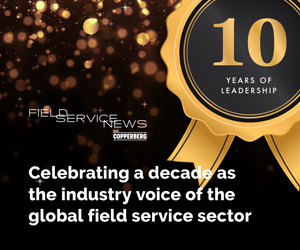02/09/2014 23:18
Ahead of taking part in a live panel discussion on End to End field service management at this years Field Service Europe Conference, Field Service News Editor Kris Oldland, will be writing a series of features around the topic…
End-to-end field service management is a topic that we keep hearing about. Indeed our own recent podcast featuring Paul Sparkes, Product Director at Advanced Field Services focussed on the big question – just what is end-to-end field service management?
Paul gave both a detailed and candid response to this question, looking at the broader picture rather than from just his own organisations standpoint and if you haven’t yet listened to this podcast you can find it on the link above.
However, whilst we talked in depth about the end-to-end concept from a software point of view, from field service specific point of view as well as the wider viewpoint of having a number of systems (such as ERP and CRM) fully integrated as well, the conversation remained focussed on software and software alone.
All well and good but if we are to explore a fully end-to-end field service solution then we must consider other elements as well.
What type of hardware do our field service engineers require? What about in-vehicle computing? Telematics? Will our field service engineers be creating orders in the field? In which case what about mobile payment options? What about printing options for providing invoices and receipts?
Understanding the needs of both your customers and your field service engineers is crucial to ensuring that you’re investing in the right technology.
Understanding your customers lifecycle
The first place to focus, as with almost anything in business, is on your customers.
Whilst the benefits of implementing the right technology will of course improve your field service operation, the underlying reason for investment in technology should be “how can my customers benefit from this.”
Of course the two are not mutually exclusive, indeed if you bring anything into your business that benefits your customer then it will almost certainly bring benefits to your company as well.
For example if your field engineers are given devices that are capable of video calls and 4G data transfer; the likelihood is that your field service engineers will be far more likely to improve first time fix rates as they will be able to access a wider pool of engineer knowledge whilst on premise than they would have had previously.
[quote float=”left”]What a waste it would be to invest in a mobile printer for each van in your fleet only to find out that 90% of your customers throw the hardcopy away after they have scanned it and would have preferred being sent documents by email anyway![/quote] Your customer is happy as the disruption to his business is minimal.
The benefits to your company are that your field service engineers are working more effectively, so they are achieving more with less, all while maintaining great service standards.
This example, whilst highlighting the point of working to a customer centric model, is fairly obvious. However, if you keep your customers at the heart of your focus other less obvious but equally important points may arise.
For example, I mentioned in my introduction mobile printers. Do you know how your clients deal with receipts or invoices for example? Many companies including ourselves here at 1927 Media try to minimise the use of hardcopies in an effort to be more environmentally focussed.
What a waste it would be to invest in a mobile printer for each van in your fleet only to find out that 90% of your customers throw the hardcopy away after they have scanned it and would have preferred being sent documents by email anyway!
This information is almost certainly already held in your company somewhere; probably the easiest way of finding out is by asking your accounts team. I’m sure they could easily put together an overview of which of your clients require paper invoicing pretty quickly as they are dealing with your customers invoicing on a regular basis.
Lets say 50% of your clients need printed documents, maybe you could allocate printers based on the daily workload each field service engineer rather than fitting all your vehicles with them?
Would this be a more cost effective route? Of course you would have to look at the options. However, by taking a greater interest in your customers needs then you are able to seek out smarter ways of implementing your own technology
This of course can free up funds for other areas of investment too.
Understanding your field engineers working environment
Another important factor when considering purchasing hardware for your mobile workforce is the environment they will be operating in.
For some companies such as couriers or delivery organisations often a simple consumer device can be sufficient. If your mobile worker simply needs an interface that allows him to see his updated schedule and collect a signature then a low cost tablet could very well be the solution.
However, what if your engineer works in a more demanding environment where the device is likely to get wet, or is required to operate in temperatures beyond normal operating thresholds? Is the device likely to be knocked about a bit as part of its general day to day use?
As Ian Davies of Motion Computing noted in his excellent article on this subject
“A recent survey from VDC highlights the causes of this expense in using consumer grade units. As part of a research project among IT decision makers at 215 companies managing a mobile device deployment, VDC discovered that the leading cause of device failure was that the tablet had been dropped.
The second cause was software issues but this was only marginally ahead of exposure to water and liquid (and just over 1 in 4 tablet PCs will face such exposure). Other leading causes of failure include excessive heat / cold, dust exposure and vibration.”
Understanding Total Cost of Ownership is a massive factor in deciding whether you should be perhaps taking the more expensive option, if in the long term you will see a greater lifespan per unit. It is essential you take into account your field service operatives working environment as well as their general workflow when considering which type of mobile hardware is right for your organisation.
We have barely scratched the surface of another area in the great end-to-end field service management question by looking at just some of the many considerations around hardware.
However, we will be continuing this series of features across the coming weeks to help you build a wider picture of all of the factors you should be considering when looking to build a fully end-to-end service management solution including revisiting some of the questions around software, a closer look at hardware and of course telematics, yet another crucial piece of the puzzle.
I am also particularly looking forward to participating in a panel debate on this topic at the Field Service Europe Conference which is shaping up to be a fantastic event.
[quote style=”boxed”]Should you wish to attend the event, which is held in Amsterdam on the 20th to the 22nd October, then you can register for tickets by clicking this link[/quote]









